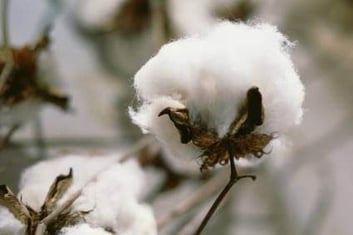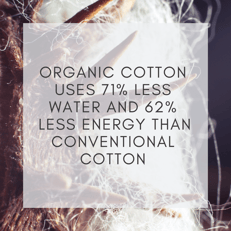Embracing net zero with cotton isn't just a green obligation, it's a strategic opportunity
Following our article; Net Zero Materials Transition in the Fashion Industry, here we focus on how cotton can become a net-zero material. We'll explore the environmental challenges and opportunities presented by cotton in 2024 and beyond.
Table of contents:
What are the Options for a Sustainable Future?
Innovation in Cotton Processing
How to Transition to Sustainable Cotton
Why focus on cotton?
When looking at ways to make a transition to net-zero materials, it's essential to assess which materials have the potential to be net-zero. We talked about legislation and the low-hanging fruit of plastics, packaging, and circularity in our first article, here we're going to look at the scale and global impact.
Cotton is a well-loved, familiar material; it's breathable, it's comfortable, it's natural and it is fashion's second most popular fibre after polyester. Yet the vast majority of cotton farms are heavily industrialised and it is by far one of the most polluting and environmentally damaging crops in the world...
Each year, 26.2 million tonnes of cotton is produced for the textile and apparel industries. It has the potential to be a sustainable, net-zero fabric of the future, but today its production and use have a major negative environmental impact and undermine the industry’s ability to maintain future production.
So, for retailers dealing in cotton, a familiar yet complex material, the question arises: how do we move towards a sustainable future?
The problem with cotton
The major problems are water consumption and contamination, chemical use, pollution and soil erosion and degradation.
Did you know that it takes 2,700 litres of water to produce one t-shirt? This video clearly illustrates the cotton production process and why cotton is a priority material for net zero transition.
Fast-growing cotton crops require intense irrigation, chemical fertilisers and pesticides. The huge amount of water used depletes natural water reserves significantly and causes ecological damage.
A particular problem caused by industrial agricultural practices is the loss of carbon from the soil, the reduction of soil health and the loss of ecological diversity.
Cotton, particularly denim, also requires several stages of wet processing which produces large amounts of wastewater. Bleaching and dyeing cotton can also cause contaminated wastewater in local rivers and water bodies.
However, cotton does have the potential to be a net-zero crop, and even “to offer a net-positive contribution, if regenerative agricultural practices become the new norm”.
What are the options for a sustainable future?
Organic cotton
Cultivated without the use of synthetic fertilisers, pesticides or genetic modification, organic cotton significantly reduces the industry's reliance on chemicals and promotes soil health. It is supposed that organic cotton uses less water than conventional cotton, to what extent is contested, but it is likely because pesticide use increases water usage whereas organic cotton farms can rely on rain and groundwater.
However, problems arise from a shortage of supply and high costs. Organic cotton is more expensive and more susceptible to crop failure, making it vulnerable to supply issues. To grow the same yields as a conventional crop organic cotton farmers would need more land and more water. As this Forbes article expounds: "organic [cotton] farming has significant growth limitations despite being ecologically sound" and makes up just 1% of annual cotton yields.
Furthermore, ironically, increased demand means sourcing organic cotton is more difficult, has a longer lead-in, and is pushing up the price.
Organic farming practices protect the environment with strict criteria of no pesticides, no synthetic fertilisers, and no GM crops, regenerative agriculture allows responsible controlled use of pesticides, with special attention to the overall ecological system prioritising soil health.
Responsibly sourced cotton
This is when responsibly sourced cotton initiatives can form a strategic stepping stone.
Responsibly sourced cotton is usually less expensive than organic cotton. Initiatives work hard to train the farmers to use water efficiently and to care for natural habitats, reducing harmful chemicals and respecting workers' rights. These initiatives usually permit the use of pesticides and genetically modified seeds – allowing for higher yields and lower input costs for farmers. [source: The Organic Cotton Connundrum]
Importantly, there is evidence that cotton produced using regenerative agriculture techniques can be net-zero carbon. For example, Good Earth Cotton® sequesters more carbon than it emits through its entire growth life cycle.Segura enables retailers to map their supply chain to tier-n. In short, that means from farm to fibre, yarn to fabric, garment to store. Retailers can map where the cotton in a t-shirt was grown, treated, woven, and sewn. This data can then be presented to consumers through our Digital Product Passport Module.
Innovation in Cotton Processing
What about reducing water usage and environmental damage caused by cotton processing? Retailers and brands need to work with suppliers to modernise wet processing or seek out suppliers who are modernising. For example:
- Modern upgraded machinery uses closed-loop systems that minimise water leakage. Look for features like overflow prevention controls and automatic water-level adjustments.
- Low-water dyes and chemicals: traditional dyes and finishing agents are notorious water guzzlers. Explore alternatives like pigment dyes and enzymatic treatments that require significantly less water.
- Water recycling and treatment: implement technologies to treat and reuse wastewater from various stages of processing. This reduces overall water consumption and minimises wastewater discharge.
A feature of Segura's traceability solution is that retailers can specifically request information from suppliers, and calculate water and carbon output based on that data.
How to transition to sustainable cotton
Transitioning to net zero with cotton is a marathon, not a sprint. It requires time, commitment, collaboration, and a willingness to embrace change. Our established users of Segura have found that focusing on two or three significant metrics initially, which can then be worked on with suppliers moving forward, has brought about measurable change.
Take a closer look at your supply chain: The first step in your journey is to review how you work today. Through supply chain transparency and traceability, you’ll be able to uncover the best routes to improvement. Uncover and partner with responsible cotton producers and manufacturers to build ethical, sustainable and innovative practices.
Introduce solutions for a greener future: introducing innovative practices like organic farming, alternative farming methods & regenerative agriculture, and recycled cotton to minimise environmental impact. Look at the product life cycle and consider how to build innovative circular practices.
Engage your customers: Once you have the transparency and the data you need, you can see how far you’ve come. You can then develop strategies for communicating your sustainability efforts and building a community of eco-conscious shoppers.
Then the rewards are vast – a thriving planet, a loyal customer base, and the satisfaction of leaving a lasting legacy of more sustainable practices and environmental responsibility.
Read more on Net-Zero Materials Transition in the Fashion Industry, or take a deep dive into another fabric here:
Net-Zero Materials Transition by Fabric
Cotton Denim LeatherPolyesterViscose
Read more about Segura’s powerful supply chain traceability tools.
About Segura
Segura is the leading fashion supply chain traceability solution, empowering fashion retailers and brands to deliver ethical, sustainable and efficient multi-tier supply chains.
Segura provides n-tier mapping, transparency, traceability, visualisation, compliance and reporting. Segura sits in the centre of your supply chain management structure creating a central repository for all your supply chain, ESG-related data and evidence, including from third-party data sources.
With all supply chain traceability data stored on a single platform, our customers get the right evidence in the right place to back up claims and meet regulatory compliance.
To keep up to date with our latest news; subscribe to our newsletter
To learn more about how Segura can help you manage your supply chain; contact us today







